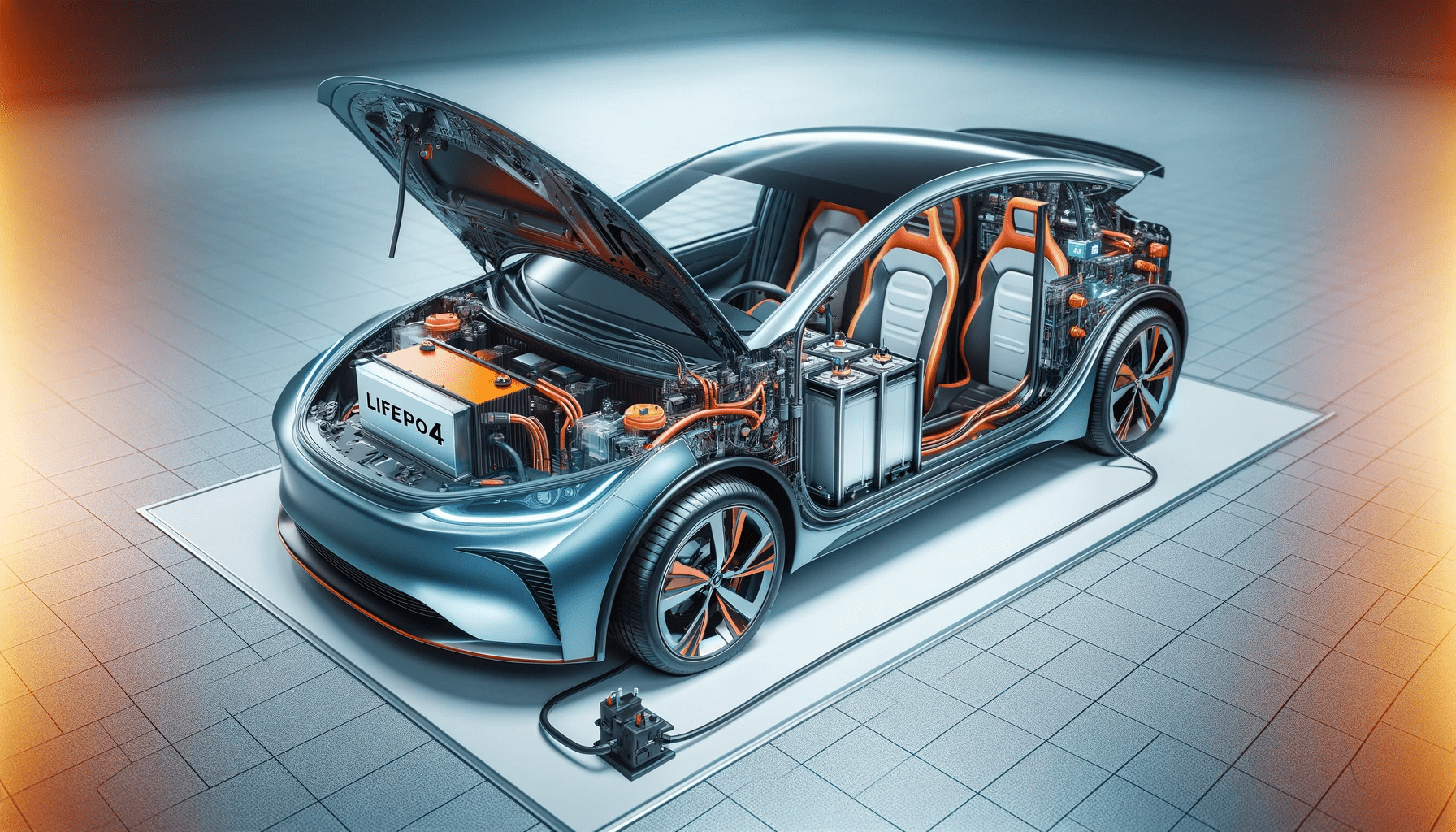Understanding the Power of LiFePO4 Batteries
When it comes to rechargeable batteries, one name stands out among the rest: LiFePO4. Short for lithium iron phosphate, this powerful battery chemistry has revolutionized the world of energy storage. Let’s dive deeper into the definition and unique characteristics ofLiFePO4 batteries, so you can fully grasp their potential.

Decoding the LiFePO4 Abbreviation
Before we delve into the wonders of LiFePO4 batteries, let’s decode the abbreviation. “Li” represents lithium, a lightweight and highly reactive metal. “Fe” stands for iron, a sturdy and abundant element. Finally, “PO4” symbolizes phosphate, a compound known for its stability and conductivity. By combining these elements, we unlock the power of LiFePO4 batteries.

An Inside Look at the Chemical Composition
LiFePO4 batteries consist of a cathode material made of lithium iron phosphate, an anode material composed of carbon, and an electrolyte that facilitates the movement of lithium ions between the cathode and anode. This specific chemical composition is the secret behind the exceptional performance of LiFePO4 batteries.
Unleashing the Power: Key Characteristics of LiFePO4 Batteries
Now that we understand the building blocks, let’s explore the remarkable characteristics that make LiFePO4 batteries the top choice for various applications.
First and foremost, LiFePO4 batteries offer an impressive energy density. This means they can store a significant amount of energy in a compact size, making them perfect for portable devices and electric vehicles alike.
Furthermore, LiFePO4 batteries boast an exceptional cycle life. Unlike other batteries that deteriorate over time, LiFePO4 batteries can be charged and discharged countless times without significant capacity loss. This longevity ensures that your devices keep running smoothly for years to come.
When it comes to safety, LiFePO4 batteries take the crown. Their excellent thermal stability and enhanced safety features make them less prone to overheating or combustion compared to other battery chemistries. With LiFePO4 batteries, you can have peace of mind knowing that your energy storage solution is reliable and secure.
So, whether you’re powering up your smartphone, driving an electric vehicle, or storing renewable energy, LiFePO4 batteries are the ultimate choice. With their unique chemical composition and exceptional characteristics, they are a true game-changer in the world of energy storage.
What is a LiFePO4 Battery? Advantages and Benefits Explained
LiFePO4 batteries, also known as lithium iron phosphate batteries, are a type of rechargeable battery that offer numerous advantages over other battery types. These batteries have gained popularity in various applications due to their exceptional performance and reliability.
Long Lifespan Compared to Other Battery Types
One of the standout advantages of LiFePO4 batteries is their impressive lifespan. These batteries can endure thousands of charge-discharge cycles, ensuring a reliable power source for an extended period. Compared to other battery chemistries like lead-acid or lithium-ion, LiFePO4 batteries offer exceptional longevity, making them a cost-effective option in the long run. Whether it’s powering electric vehicles or providing backup energy storage, LiFePO4 batteries can be relied upon for consistent performance over time.
High Energy Density and Capacity
LiFePO4 batteries boast a high energy density, meaning they can store a significant amount of energy in a compact size. This characteristic makes them ideal for applications where space is limited, such as electric vehicles or portable electronic devices. Despite their small size, LiFePO4 batteries also have a high capacity, allowing them to deliver sustained power over extended periods without a significant drop in performance. Whether it’s running a smartphone or powering an electric car, LiFePO4 batteries provide the energy needed for uninterrupted usage.
Enhanced Safety Features and Stability
When it comes to safety, LiFePO4 batteries excel. Unlike other lithium-ion batteries, LiFePO4 batteries are less prone to thermal runaway or combustion, even under extreme conditions. This enhanced safety feature makes them a preferred choice for applications where safety is of utmost importance, such as electric vehicles or renewable energy storage systems. With LiFePO4 batteries, users can have peace of mind knowing that their power source is reliable and secure.
Fast Charging Capabilities
Time is often a limiting factor, especially in applications where frequent charging is required. LiFePO4 batteries offer a solution with their fast charging capabilities. These batteries can recharge quickly compared to other battery chemistries, ensuring minimal downtime and maximum efficiency. Whether it’s an electric vehicle, portable electronic device, or renewable energy system that relies on intermittent power sources, LiFePO4 batteries can keep up with demanding charging needs.
Environmentally Friendly and Recyclable
In today’s world, environmental consciousness is crucial. LiFePO4 batteries contribute to a greener and cleaner future as they are considered environmentally friendly and recyclable. Unlike other battery chemistries, LiFePO4 batteries do not contain toxic heavy metals like lead or cadmium. This not only reduces their environmental impact but also promotes sustainable practices. By choosing LiFePO4 batteries, users can make an eco-conscious choice without compromising on performance or reliability.
What is a LiFePO4 Battery and Its Applications?
LiFePO4 batteries, also known as lithium iron phosphate batteries, are widely used due to their unique characteristics. These batteries have a high energy density, long cycle life, and enhanced safety features. Let’s dive deeper into what a LiFePO4 battery is and explore its applications in various industries.
Electric Vehicles and Hybrid Cars

One of the prominent applications of LiFePO4 batteries is in electric vehicles (EVs) and hybrid cars. These batteries offer a high power density, allowing EVs to achieve longer driving ranges and improved performance. With a longer cycle life compared to other lithium-ion batteries, LiFePO4 batteries are a reliable choice for the automotive industry.
Renewable Energy Storage Systems

LiFePO4 batteries are extensively used in renewable energy storage systems, such as solar and wind power installations. These batteries efficiently store the energy generated from renewable sources and provide a reliable power supply when the primary source is unavailable. Their ability to handle high charge and discharge rates makes them ideal for renewable energy applications.
Portable Electronic Devices
LiFePO4 batteries find widespread use in portable electronic devices like smartphones, tablets, laptops, and power banks. Compared to traditional lithium-ion batteries, these batteries offer a longer lifespan, improved safety, and faster charging capabilities. Their compact size and lightweight nature make them a popular choice for portable devices.
Marine and Recreational Vehicles

LiFePO4 batteries are well-suited for marine and recreational vehicles, such as boat battery, yachts, and lithium rv batteries. These batteries can withstand harsh marine environments, provide reliable power for extended periods, and have a longer lifespan compared to traditional lead-acid batteries. Additionally, their lightweight design helps optimize the overall weight of the vehicles.
Industrial and Medical Equipment

LiFePO4 batteries are extensively used in various industrial and medical equipment. These batteries offer stable and consistent power supply, making them suitable for critical applications in industries such as manufacturing, logistics, and telecommunications. In the medical field, LiFePO4 batteries power devices like portable medical equipment, patient monitoring systems, and emergency backup systems.
In summary, LiFePO4 batteries have diverse applications across different industries, ranging from automotive and renewable energy to portable electronics and medical equipment. Their unique combination of high energy density, long cycle life, and enhanced safety features makes them a reliable and efficient choice for various power storage requirements.
Understanding the Charging and Discharging Process of LiFePO4 Batteries
Exploring the Intricacies of LiFePO4 Battery Charging
When it comes to charging a LiFePO4 battery, it’s all about a carefully controlled transfer of electric energy into the battery cell. This process involves applying a constant voltage, typically around 3.6 to 3.7 volts per cell, to the battery. As a result, the lithium ions in the cathode make their way across the electrolyte and get intercalated into the anode material, which is typically made of carbon.
Why is this intercalation of lithium ions so important? Well, it’s what charges the battery and increases its energy storage capacity. And here’s the fascinating part: LiFePO4 batteries have a remarkable ability to handle high charge and discharge rates without experiencing significant capacity loss. This unique characteristic makes them ideal for a wide range of applications, including electric vehicles and renewable energy storage.
An In-Depth Look at LiFePO4 Battery Discharging
Now, let’s delve into the process of discharging a LiFePO4 battery. This is when the stored energy is released, allowing the lithium ions to move from the anode to the cathode and creating an electric current. As the battery discharges, you’ll notice a gradual decrease in the potential difference or voltage across the terminals, indicating a reduction in available energy.
What sets LiFePO4 batteries apart is their flat discharge voltage profile. Essentially, this means that they maintain a relatively constant voltage throughout most of the discharging process. This stability in power output is a huge advantage for applications that require a consistent energy supply, such as power tools and portable electronics.
Unveiling the Factors that Influence Charging and Discharging Performance
Now that we understand the charging and discharging processes, let’s explore the factors that can impact the performance of LiFePO4 batteries. One crucial factor is the operating temperature of the battery. Extreme temperatures can have a significant effect on both the efficiency and overall lifespan of the battery.
Another critical consideration is the charging and discharging rates, also known as C-rates. While LiFePO4 batteries can handle high C-rate charging and discharging, it’s important to avoid excessive rates, as they can lead to reduced cycle life.
The state of charge (SoC) of the battery, the depth of discharge (DoD), and the number of charge and discharge cycles also play a crucial role in determining the long-term reliability and capacity retention of LiFePO4 batteries. Proper management of these factors is essential for maximizing the efficiency and longevity of these batteries in various applications.
Maintenance and Care for LiFePO4 Batteries: Maximizing Lifespan and Performance
Proper Storage Guidelines: Keeping Your LiFePO4 Batteries in Optimal Condition
When it comes to LiFePO4 batteries, proper storage is crucial for maximizing their lifespan and ensuring optimal performance. To start, it’s important to store these batteries in a cool and dry place, away from direct sunlight. Aim for a storage temperature between 20°C and 25°C (68°F – 77°F) to prevent any potential damage caused by extreme temperatures.
Additionally, before storing LiFePO4 batteries for an extended period, it’s recommended to partially charge them to around 50% to 70% of their capacity. This precautionary step helps prevent over-discharge, which can be detrimental to the battery cells.
Recommended Charging Methods: Charging LiFePO4 Batteries for Longevity
LiFePO4 batteries have specific charging requirements that should be followed to ensure their longevity. It is best to use a charger specifically designed for LiFePO4 batteries, as these chargers typically have a LiFePO4 charging profile. Charging at a moderate rate, typically around 0.5C (where C represents the battery’s capacity), is ideal for extending the battery’s life.
One important aspect to keep in mind is to avoid overcharging LiFePO4 batteries. Unlike some other battery chemistries, LiFePO4 batteries are less tolerant of overvoltage. To maintain uniform voltage across the battery pack, it is recommended to regularly balance the cells during the charging process.
Temperature Considerations: Optimal Operating Conditions for LiFePO4 Batteries
Temperature is a critical factor that can significantly impact the performance and safety of LiFePO4 batteries. Extreme heat and cold should be avoided, as they can lead to capacity loss and reduced cycle life. The ideal operating temperature range for LiFePO4 batteries is between -20°C and 60°C (-4°F – 140°F).
If you find yourself operating LiFePO4 batteries in extreme conditions, it is worth considering the use of thermal management systems to regulate the temperature and ensure optimal battery performance.
Monitoring and Balancing Techniques: Ensuring the Health and Performance of LiFePO4 Batteries
Regular monitoring is essential to ensure the health and performance of LiFePO4 batteries. Utilizing a Battery Management System (BMS) is highly recommended, as it allows you to monitor crucial factors such as voltage, temperature, and state of charge.
One vital function of a BMS is cell balancing, which ensures that voltage is equalized across individual cells within a battery pack. By preventing overcharging of specific cells, cell balancing helps maintain capacity balance and prolong the overall battery life.
Common Troubleshooting Tips: Addressing Issues with LiFePO4 Batteries
If you encounter any issues with your LiFePO4 batteries, following some common troubleshooting steps can help identify and resolve the problem. Start by checking for loose connections, damaged wires, or faulty connectors. It is also important to ensure that both your charger and BMS are functioning correctly.
If your LiFePO4 battery is not holding a charge as it should, it may be time for a capacity test to assess its health. In case of any doubts or uncertainties, referring to the manufacturer’s guidelines or seeking professional assistance can help effectively diagnose and resolve any problems.
Frequently Asked Questions about LiFePO4 Batteries
What is a LiFePO4 battery?
A LiFePO4 battery, short for lithium iron phosphate battery, is a type of rechargeable battery that offers exceptional performance and reliability. It is composed of a cathode material made of lithium iron phosphate, an anode material composed of carbon, and an electrolyte that facilitates the movement of lithium ions between the cathode and anode.
What are the advantages of LiFePO4 batteries?
LiFePO4 batteries have numerous advantages over other battery types. They have a long lifespan, high energy density, enhanced safety features, and fast charging capabilities. Additionally, LiFePO4 batteries are environmentally friendly and recyclable.
What are the applications of LiFePO4 batteries?
LiFePO4 batteries are used in a wide range of applications, including electric vehicles, renewable energy storage systems, portable electronic devices, marine and recreational vehicles, and industrial and medical equipment.
How do LiFePO4 batteries charge and discharge?
LiFePO4 batteries charge by applying a constant voltage to the battery, allowing lithium ions to move from the cathode to the anode and increasing the battery’s energy storage capacity. During discharge, the stored energy is released, and the lithium ions move from the anode to the cathode, creating an electric current.
What factors influence the performance of LiFePO4 batteries?
Several factors can impact the performance of LiFePO4 batteries, including operating temperature, charging and discharging rates, state of charge, depth of discharge, and the number of charge and discharge cycles. Proper management of these factors is essential for maximizing the efficiency and longevity of LiFePO4 batteries.
How should LiFePO4 batteries be maintained and cared for?
To maximize the lifespan and performance of LiFePO4 batteries, it is important to store them in a cool and dry place, partially charge them before extended storage, use a charger specifically designed for LiFePO4 batteries, avoid overcharging, and monitor their health with a Battery Management System (BMS). Regular balancing of the cells and troubleshooting any issues are also important maintenance practices.





1 thought on “What is a LiFePO4 Battery? Understanding the Power and Characteristics”
“May you have an interesting life.” Old Chinese curse. Our future is gonna be super interesting as we transition to renewable power and EVs. I can imagine a household with 2 EVs, one of them charging during the day from solar panels. Then the other EV comes home, having gotten a charge at work or the mall, and sucks a little juice from EV #1. And maybe the grid goes down and the 2 EVs run the house. Wish I had 20 or 30 more years to see all the neat stuff coming.